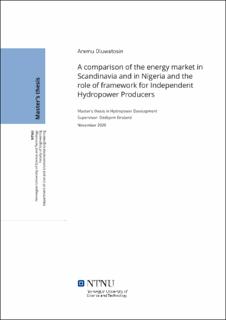| dc.description.abstract | Hydropower optimization could aid in minimizing resource input for electricity generation and overall system operations cost. This study used the EMPS modelling to analyze the performance of Nigeria’s large hydropower systems (Kainji, Jebba, and Shiroro) and used obtained results as cues to investigate how the integration of independent hydropower systems would influence the efficiency of power production in the foreseeable future.
Two case scenarios were formulated. The first case involved optimizing hydropower generation and use of water resources for hydropower production. The first steps required gathering needed data for modelling from hydrological stations of the three hydropower stations. Following this, the three hydropower stations were grouped into two distinct areas (Kainji and Jebba in ‘Area 1’ and Shiroro being the only station in ‘Area 2’). The data collected was entered as inputs into EMPS taking the area groupings into account, and EMPS was used to model the data, given historical inflow series in an optimization process. The model provided results for 21 weather scenarios, and the hydropower generation for each Area were validated using historical data. The obtained data provided satisfactory results for the Area under study.
The second case which involved modelling how the integration of more independent hydropower system could shape the efficiency of energy delivery in Nigeria was also worked out. 7 new hydropower systems were included in EMPS, and a higher power transmission capacity was modelled in the system. The results showed that the inclusion of new hydropower stations raised power production significantly and reduced the dependency of the Kainji, Jebba, and Shiroro hydropower stations.
In general, the use of EMPS to optimize the hydropower system, and model a scenario of newer hydropower station additions were satisfactory. Although, fine tuning is required to improve the obtained results.
Keywords: Hydropower; EMPS; Stochastic model; Nigeria’s hydropower modelling | |
